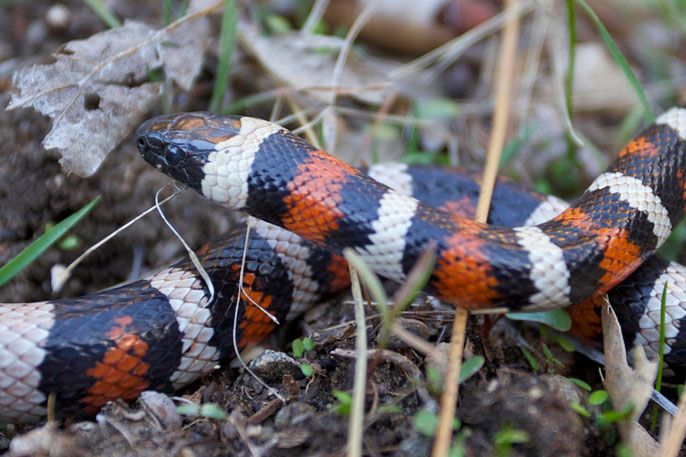
Dangerous snake? It sure is... if you are a lizard, nestling bird, or small mammal. If you are a human being, it is mostly harmless. The Sierra mountain kingsnake (Lampropeltis zonata multicincta), with its rings of white, orange, and black, has to be the most spectacularly colored snake in Yosemite. Some call it the coral kingsnake because of its somewhat similar appearance to the venomous coral snake. Fortunately for Yosemite visitors, the nearest wild coral snake lives in Arizona.
I found this one coiled up on the edge of the road near Bridalveil Fall recently. Fearing that it might become roadkill, I moved it away from the street. Tentatively at first I reached toward the snake and when it didn't try to bite me or slither away, I slipped my hand under a couple of its coils and gently lifted it. It was completely docile. Its skin was cool, dry, and smooth to the touch and not slimy like many people believe. I marveled at how it moved without any limbs. It just slid gently through my fingers. At one point it tried to wedge itself in my armpit.
After a moment appreciating this beautiful serpent, I walked out into the pine and oak woodland nearby and released it. I took a few pictures, and walked away. I had gone only a few paces when I turned around to take one last look. I was surprised at how hard it was to see despite its bright coloring. These woodlands are typical habitat for the Sierra mountain kingsnake. The bands of dark and light break up its overall shape and blend with the mottled forest floor.
This particular individual was a full-grown 40 inches long. Sierra mountain kingsnakes hunt in the daytime at this time of the year. They will become nocturnal when summer days become too hot. They move about looking for bird nests they may raid for eggs or nestlings. Small mammals like mice are also on its menu, as are other snakes. Sierra mountain kingsnakes kill their prey through constriction. That is, they suffocate their prey by throwing a few loops of their body around their prey's body and squeezing. Eventually the prey succumbs and the snake slowly swallows it whole.
I've seen Sierra mountain kingsnakes before in Yosemite Valley. They are excellent climbers. Once, while demonstrating a rescue operation at an interpretive program near Church Bowl, I saw one. I had climbed up a crack about 60 feet and set up a belay station. As I sat there belaying the second climber up, I saw a full-grown kingsnake working its way up the same crack I had just ascended. It came right up and slithered between my legs and continued on up the mountain.
To protect such innocent and beautiful creatures is yet another good reason to care for Yosemite National Park.
